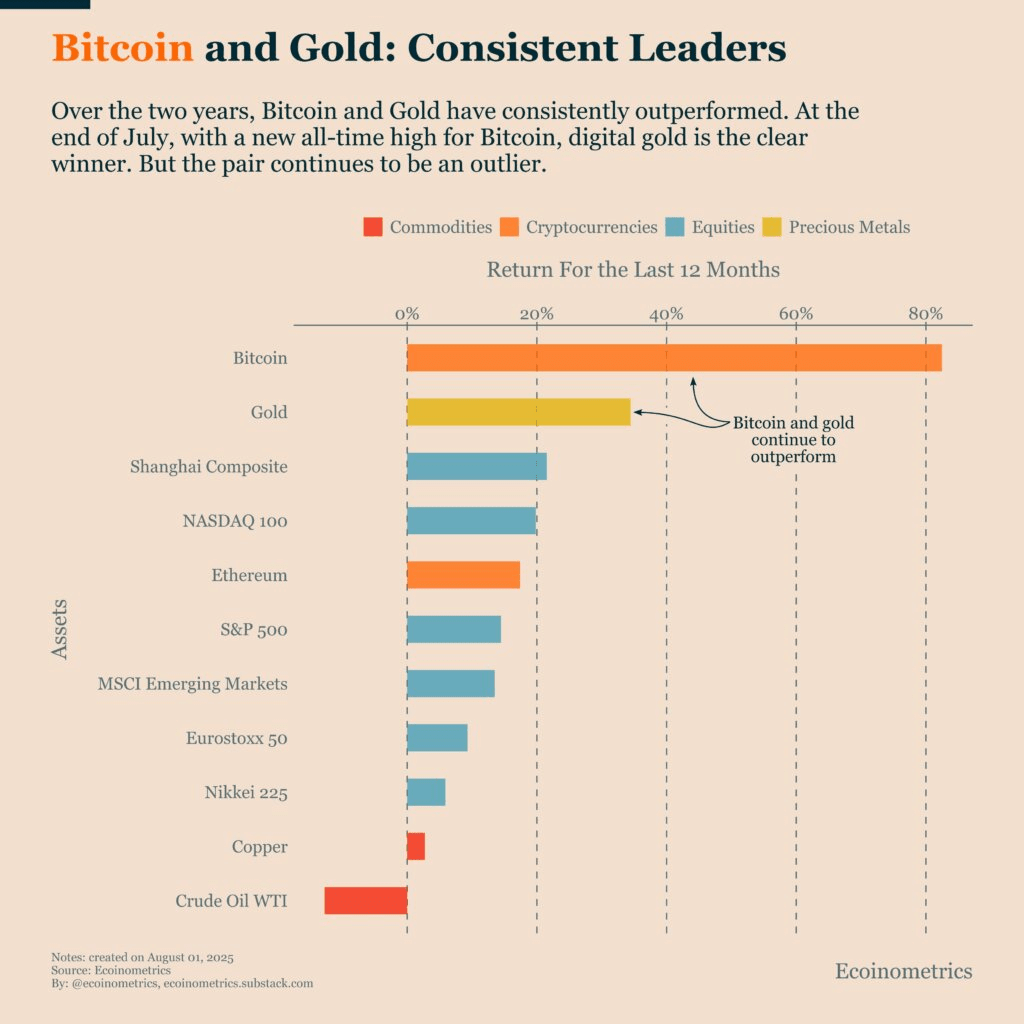As global markets plunged this week and forced liquidations along with margin calls wiped out many long leveraged positions, major traders are repositioning accordingly. The new tariffs announced by the Trump administration and weak U.S. job reports have caused concerns in global markets; the S&P 500 lost 1.6% in one day, and Bitcoin, as expected, followed the downward trend of risk sentiment. In times of uncertainty, taking a broader perspective will be beneficial: over the past two years, Bitcoin has consistently outperformed all major assets, and no asset can match it.
Bitcoin Compared to Major Assets: 2-Year Scorecard
From July 2023 to July 2025, Bitcoin has skyrocketed by 301.7%, more than quadrupling in price and solidifying its position as the top-performing asset class. As ecoinometrics points out:
“Bitcoin is down again, but the long-term picture remains unchanged… This is not a temporary phenomenon. Over the past two years, Bitcoin has consistently led.”
Bitcoin's performance far exceeds that of traditional stock investments. The leading U.S. stock index, S&P 500, has only provided a much more modest return of 38% over the past two years. Despite a strong stock market and multiple record highs for large-cap stocks, this index still cannot keep up with BTC's explosive growth.

Gold, which has seen a strong rally due to rising inflation and geopolitical instability, has increased by 69.8% over the past two years and has not been able to achieve the growth of Bitcoin, proving that every accurate prediction about Bitcoin has been true: there is no better option. As Adam Back commented:
“There is no company in second place. The second place company is the treasury.”
Even when looking at the second largest currency in the cryptocurrency sector, Ethereum, it only illustrates Back's point more clearly: ETH has grown about 56% over the past 24 months.
At the bottom of the major assets is crude oil, which has seen only slight growth over the past two years, with profits fluctuating and remaining flat into the summer of 2025.
Why Bitcoin Continues to Lead
The recent sell-off is more related to macroeconomic uncertainties, tariffs, and job concerns than any changes in Bitcoin's underlying value proposition. Bitcoin's volatility remains closely tied to the general anxiety of the market during such risk-off periods. But for two consecutive years, Bitcoin has excelled through corrections and built momentum for the asset.
The predictable supply schedule, decentralized nature, and increasing adoption by both retail and institutional investors have maintained the bullish momentum.
Meanwhile, Ethereum remains competitive but has yet to surpass BTC, and gold's reliable inflation hedge position still translates to much lower returns. Crude oil continues to struggle under the weight of fluctuating energy trends and macroeconomic pressures, providing less performance or excitement than is typically seen in digital and financial assets.
Bitcoin's short-term decline may seem dramatic, but price drops are part of its DNA and the data never lies: since mid-2023, BTC has outperformed gold, U.S. stocks, Ethereum, and crude oil. If in doubt, look further, as economists have pointed out:
“Perhaps it is not worth panicking over a move that seems more driven by sentiment than by fundamentals.”
